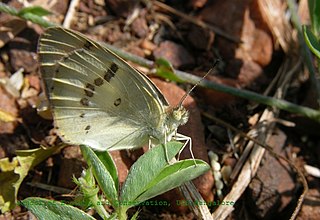Anungu schools is a group of ten schools operated by the Government of South Australia which are located in the west of the Australian state of South Australia. Eight are located in the Aboriginal lands of Anangu Pitjantjatjara Yankunytjatjara, while one is in Maralinga Tjarutja and on in the community of Yalata, all offering primary and secondary schooling to a local body of students who are largely Aboriginal.

Colotis, called orange tips or Arabs, is a genus of butterflies of the subfamily Pierinae found mainly in Africa and south-western Asia. The larvae of all Colotis species specialize on plants in the family Capparaceae.

Amata, formerly known as Musgrave Park, is an Aboriginal community in the Anangu Pitjantjatjara Yankunytjatjara Lands in South Australia, comprising one of the six main communities on "The Lands".

Amata is a genus of tiger moths in the family Erebidae. The genus was erected by Johan Christian Fabricius in 1807.

Cyanopepla is a genus of moths in the subfamily Arctiinae. The genus was erected by James Brackenridge Clemens in 1861.

Amata huebneri, the wasp moth, is a moth in the genus Amata of the family Erebidae. The species was first described by Jean Baptiste Boisduval in 1829. It is found from the Indo Australian tropics to northern Australia.
Amata insularis is a species of moth of the family Erebidae first described by Arthur Gardiner Butler in 1876. It is found in Queensland, Australia.
Amata marella is a species of moth of the family Erebidae first described by Arthur Gardiner Butler in 1876. It is found in Australia, where it has been recorded from Queensland.
Amata nigriceps is a species of moth of the family Erebidae first described by Arthur Gardiner Butler in 1876. It is found in Australia, where it has been recorded from Queensland and New South Wales.
Amata leucosoma is a moth of the subfamily Arctiinae. It was described by Arthur Gardiner Butler in 1876. It is found in Kashmir.
Amata syntomoides is a moth of the subfamily Arctiinae. It was described by Arthur Gardiner Butler in 1876. It is found in Kashmir and the north-western Himalayas.
The Far North West Sports League was formed as a joint initiative by the Commonwealth and State governments and the SANFL to promote active lifestyles in the APY lands, situated in the far north west corner of South Australia. The FNWSL is an Australian rules football and Softball competition.
Amata francisca is a moth of the family Erebidae. It was described by Arthur Gardiner Butler in 1876. It is found in the Republic of the Congo, Mozambique and Sierra Leone.
Amata johanna is a moth of the family Erebidae. It was described by Arthur Gardiner Butler in 1876. It is found in Nigeria and South Africa.
Amata marina is a moth of the family Erebidae. It was described by Arthur Gardiner Butler in 1876. It is found in Cameroon, the Republic of the Congo, the Democratic Republic of the Congo, Equatorial Guinea, Gabon, Ghana, Sierra Leone, Uganda, Zambia and Zimbabwe.
Amata tomasina is a moth of the family Erebidae. It was described by Arthur Gardiner Butler in 1876. It is found in Cameroon, the Democratic Republic of the Congo, Equatorial Guinea, Ethiopia, Ivory Coast, Rwanda, Sierra Leone, Sudan, Gambia and Uganda.




